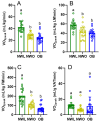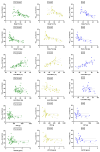Influence of Sex and Body Composition on Aerobic Capacity in Normal Weight Lean, Normal Weight Obese, and Obese Phenotypes
- PMID: 39857556
- PMCID: PMC11765120
- DOI: 10.3390/ijerph22010103
Influence of Sex and Body Composition on Aerobic Capacity in Normal Weight Lean, Normal Weight Obese, and Obese Phenotypes
Abstract
Normal weight obesity (NWO) is a body composition phenotype that is associated with increased cardiometabolic risk and is characterized by a normal weight body mass index but elevated body fat. The purpose of this study was to determine sex differences in aerobic capacity across body composition phenotypes, including normal weight lean (NWL), NWO, and traditional obesity (OB). We recruited 60 participants according to three body composition phenotypes: NWL (n = 10 females, n = 10 males), NWO (n = 10 females, n = 10 males), and OB (n = 10 females, n = 10 males). Measurements included fasting metabolic risk factors, body composition X-ray scan, and peak exercise test on a cycle ergometer to determine aerobic capacity (VO2peak). Across groups, males (34.5 ± 11.7 mL/kg/min) exhibited greater VO2peak than females (28.8 ± 8.8 mL/kg/min; p = 0.04). There were no differences in VO2peak between sexes within the same body composition phenotype, but NWL (42.7 ± 9.0 mL/kg/min) exhibited greater VO2peak than NWO (27.9 ± 4.4 mL/kg/min; p < 0.0001) and OB (24.4 ± 7.3 mL/kg/min; p < 0.0001). VO2peak was inversely correlated with relative body fat in the full sample (r = -0.67; p < 0.0001), but was stronger in males (r = -0.78; p < 0.0001) than females (r = -0.53; p = 0.0028). Visceral adipose tissue was not significantly correlated with VO2peak in the full sample (r = -0.25; p = 0.05) or in males (r = -0.23; p = 0.25), although they were inversely correlated in females (r = -0.36; p = 0.048). Our results suggest low aerobic capacity in both men and women with NWO, similar to men and women with OB. The relationship between body composition and aerobic capacity is strong across body composition phenotypes, but appears to be more consistent in females than males. For healthcare professionals aiming to lower cardiometabolic risk, attention should be given to improving aerobic fitness in both men and women with elevated body fat, including those with NWO.
Keywords: BMI; VO2peak; aerobic capacity; body composition; body mass index; lean mass; normal weight obesity; obesity; sex differences; visceral adipose tissue.
Conflict of interest statement
The authors declare no conflicts of interest.
Figures



Similar articles
-
Normal Weight Obesity Overview and Update: A narrative review.Curr Obes Rep. 2025 May 30;14(1):50. doi: 10.1007/s13679-025-00641-z. Curr Obes Rep. 2025. PMID: 40447890 Review.
-
Physical Fitness but Not Diet Quality Distinguishes Lean and Normal Weight Obese Adults.J Acad Nutr Diet. 2020 Dec;120(12):1963-1973.e2. doi: 10.1016/j.jand.2020.07.020. Epub 2020 Oct 1. J Acad Nutr Diet. 2020. PMID: 33011149 Free PMC article.
-
Adolescents with Normal Weight Obesity Have Less Dry Lean Mass Compared to Obese Counterparts.Int J Environ Res Public Health. 2025 Jan 27;22(2):171. doi: 10.3390/ijerph22020171. Int J Environ Res Public Health. 2025. PMID: 40003397 Free PMC article.
-
Health Behavior and Metabolic Risk Factors Associated with Normal Weight Obesity in Adolescents.PLoS One. 2016 Aug 25;11(8):e0161451. doi: 10.1371/journal.pone.0161451. eCollection 2016. PLoS One. 2016. PMID: 27560824 Free PMC article.
-
New obesity classification criteria as a tool for bariatric surgery indication.World J Gastroenterol. 2016 Jan 14;22(2):681-703. doi: 10.3748/wjg.v22.i2.681. World J Gastroenterol. 2016. PMID: 26811617 Free PMC article. Review.
Cited by
-
Normal Weight Obesity Overview and Update: A narrative review.Curr Obes Rep. 2025 May 30;14(1):50. doi: 10.1007/s13679-025-00641-z. Curr Obes Rep. 2025. PMID: 40447890 Review.
References
-
- More than Half of U.S. Adults Don’t Know Heart Disease Is Leading Cause of Death, Despite 100-Year Reign. [(accessed on 1 August 2024)]. Available online: http://newsroom.heart.org/news/more-than-half-of-u-s-adults-dont-know-he....
-
- FastStats—Leading Causes of Death. [(accessed on 13 December 2024)]; Available online: https://www.cdc.gov/nchs/fastats/leading-causes-of-death.htm.
-
- Ross R., Blair S.N., Arena R., Church T.S., Després J.-P., Franklin B.A., Haskell W.L., Kaminsky L.A., Levine B.D., Lavie C.J., et al. Importance of Assessing Cardiorespiratory Fitness in Clinical Practice: A Case for Fitness as a Clinical Vital Sign: A Scientific Statement from the American Heart Association. Circulation. 2016;134:e653–e699. doi: 10.1161/CIR.0000000000000461. - DOI - PubMed
MeSH terms
Grants and funding
LinkOut - more resources
Full Text Sources
Medical
Miscellaneous

